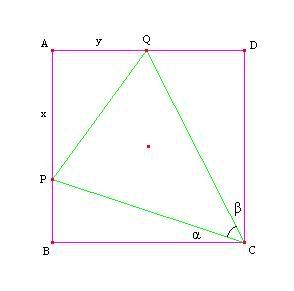
Solution: Let $ AP = x, AQ = y $ and $ \angle PCB = \alpha, \angle QCD = \beta $. By the given condition, we have $ AP+AQ+QP = x+y+\sqrt{x^2+y^2} = 2 $ (1). From this, we find
$ x+y = 2-\sqrt{x^2+y^2} $
$ (x+y)^2 = 4-4\sqrt{x^2+y^2}+(x^2+y^2) $
$ xy = 2-2\sqrt{x^2+y^2} $
Substituting $ \sqrt{x^2+y^2} = 2-x-y $ from (1), we have
$ xy = 2-2(2-x-y) \Rightarrow 2-x-y = x+y-xy \Rightarrow \frac{2-x-y}{x+y-xy} = 1 $ (2).
Note that $ \tan{\alpha} = \frac{PB}{BC} = 1-x $ and $ \tan{\beta} = \frac{QD}{DC} = 1-y $. Then
$ \tan{(\alpha+\beta)} = \frac{\tan{\alpha}+\tan{\beta}}{1-\tan{\alpha} \cdot \tan{\beta}} = \frac{(1-x)+(1-y)}{1-(1-x)(1-y)} = \frac{2-x-y}{x+y-xy} $.
But by (2), we have $ \tan{(\alpha+\beta)} = \frac{2-x-y}{x+y-xy} = 1 \Rightarrow \alpha+\beta = 45^{\circ} $.
Hence $ \angle PCQ = 90^{\circ}-(\alpha+\beta) = 45^{\circ} $. QED.
--------------------
Comment: Trigonometry can come in handy quite often, especially when dealing with angles. Purely geometric solutions to this problem are a lot more complicated in my opinion; when in doubt, use algebra. The following identity comes in handy on quite a few problems.
--------------------
Practice Problem: Prove that in any triangle we have $ \tan{\frac{A}{2}} \cdot \tan{\frac{B}{2}} + \tan{\frac{B}{2}} \cdot \tan{\frac{C}{2}} + \tan{\frac{C}{2}} \cdot \tan{\frac{A}{2}} = 1 $.
Inscribing a circle into triangle ABC, and using a = x + y, b = y + z, c = z + x, and r, we find that the identity is equivalent to
ReplyDeleter^2 / xz + r^2 / xy + r^2 / yz = 1
By Heron's, the area of the triangle A = \sqrt{xyz(x+y+z)} = (x+y+z)r, so A^2 / A^2 = 1 = r^2 (x + y + z) / xyz = 1, which is equivalent to the above identity. QED.
Don't you think you should start to slow down a little. USAMO is in two days!!!
ReplyDeleteTomorrow is my cool down period for the year :).
ReplyDeleteHaha, nice. Well, good luck on the USAMO. You are a great role model. You've worked hard and improved so much in one year.
ReplyDeleteI wonder if this proof is valid:
ReplyDeleteFrom the equations AP + AQ + PQ = 2, AP = 1 - PB, and AQ = 1 - QD we get
PQ = PB + QD
This means that triangles PCB and QCD can be "flipped" inward along PC and QC respectively to fill up triangle PCQ.
Then we have 2(alpha + beta) = 90, or alpha + beta = 45 which means alpha + beta = angle PCQ = 45.
That's interesting. Intuitively, it makes sense, but I'm not completely sure if I would be able to rigorously prove it. A good idea, though!
ReplyDeleteHmm, I guess "flipping triangles" inward is not the best way to put it.
ReplyDeleteHow about:
rotate triangle PCB so that BC lines up with DC. Then the newly formed triangle
"PCQDB" is SSS congruent with the original PCQ, so alpha + beta = angle PCQ, and alpha+beta + angle PCQ = 90, so PCQ = 45
I think you can prove it... draw an altitude down from c to pq and use algebra about the triangle areas and stuff
ReplyDelete